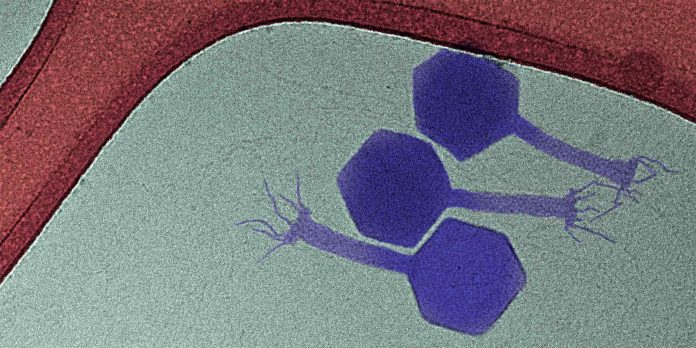ແບັກທີເລຍ dormancy is survival strategy in response to stressful exposure to antibiotics taken by a patient for treatment. The dormant cells become tolerant to antibiotics and are killed at slower rate and survive sometimes. This is called ‘antibiotic tolerance’ which is unlike antibiotic resistance when ເຊື້ອແບັກທີເຣັຍ grow in the presence of antibiotics. Chronic or relapsing infections are attributed to antibiotic tolerance, for which there is no effective treatment. Phage therapy has long been considered but the dormant bacterial cells are non-responsive and refractory to known bacteriophages. Scientists of ETH Zurich have identified a new bacteriophage that uniquely replicates on deep stationary-phase cultures of Pseudomonas aeruginosa. Named ‘Paride’, this bacteriophage could kill deep-dormant P. aeruginosa by direct lytic replication. Interestingly, this novel phage reduced bacterial loads through phage-antibiotic synergy when meropenem antibiotic was added to cultures. Apparently, the novel phage could exploit weak spots in the physiology of dormant bacteria to overcome antibiotic tolerance. These weak spots could be targets of new treatment for chronic infections caused by dormant or inactive bacteria.
Most bacteria on Earth are in dormant state of reduced metabolic activity or in completely inactive form of spore. Such ແບັກທີເລຍ cells can be readily resuscitated when required nutrients and molecules become available.
ແບັກທີເລຍ dormancy or inactivity is the survival strategy in response to stressful external environmental conditions like starvation or exposure to antibiotics taken by a patient for treatment. In later case, the dormant cells become tolerant to antibiotics because cellular processes targeted by the antibiotics to kill ເຊື້ອແບັກທີເຣັຍ are turned down. This phenomenon is called ‘ຄວາມທົນທານຕໍ່ຢາຕ້ານເຊື້ອ' ໃນກໍລະນີທີ່ເຊື້ອແບັກທີເຣັຍໄດ້ຖືກຂ້າຕາຍໃນອັດຕາຊ້າແລະຢູ່ລອດໃນບາງຄັ້ງ (ບໍ່ຄືໃນກໍລະນີຂອງ ຄວາມຕ້ານທານຢາຕ້ານເຊື້ອ ໃນເວລາທີ່ເຊື້ອແບັກທີເຣັຍຂະຫຍາຍຕົວຢູ່ໃນທີ່ປະທັບຂອງຢາຕ້ານເຊື້ອ). ການຕິດເຊື້ອແບບຊໍາເຮື້ອ ຫຼື ຊ້ຳເຮື້ອແມ່ນເນື່ອງມາຈາກຈຸລັງແບັກທີເຣຍທີ່ທົນທານຕໍ່ຢາຕ້ານເຊື້ອທີ່ພັກເຊົາ, ມັກຈະເອີ້ນວ່າ "ທົນນານ", ເຊິ່ງບໍ່ມີການປິ່ນປົວທີ່ມີປະສິດທິພາບ.
Phage therapy involving bacteriophages or phages (i.e., ໄວຣັສ that predate ເຊື້ອແບັກທີເຣັຍ), has long been considered for treating chronic infections by dormant or inactive ເຊື້ອແບັກທີເຣັຍ however this approach works when host ແບັກທີເລຍ cells are undergoing growth. The dormant or inactive ແບັກທີເລຍ cells, however, are non-responsive and refractory to the bacteriophages which either avoid adsorption to the ແບັກທີເລຍ cell surfaces or hibernate in the dormant cells until resuscitation.
Known bacteriophages do not have ability to infect antibiotic-tolerant, deep-dormant or inactive ເຊື້ອແບັກທີເຣັຍ. It was thought that given diversity, phages with ability to infect dormant cells may exist in nature. Researchers have now identified one such novel bacteriophage for the first time.
ໃນການສຶກສາຈັດພີມມາບໍ່ດົນມານີ້, ນັກວິທະຍາສາດຂອງ ETH Zurich ລາຍງານການໂດດດ່ຽວຂອງ bacteriophage ໃຫມ່ທີ່ເປັນເອກະລັກ replicates ກ່ຽວກັບວັດທະນະທໍາໄລຍະ stationary ເລິກຂອງ Pseudomonas aeruginosa ຢູ່ໃນຫ້ອງທົດລອງ. ພວກເຂົາເຈົ້າໄດ້ຕັ້ງຊື່ນີ້ bacteriophage Paride. Phaage ນີ້ສາມາດຂ້າຄວາມງຽບສະຫງົບໄດ້ P. aeruginosa ໂດຍການຈໍາລອງ lytic ໂດຍກົງ. ເປັນທີ່ຫນ້າສົນ, phage ນະວະນິຍາຍນີ້ຫຼຸດຜ່ອນການໂຫຼດຂອງເຊື້ອແບັກທີເຣັຍໂດຍຜ່ານ synergy phage-antibiotic ໃນເວລາທີ່ຢາຕ້ານເຊື້ອ meropenem ໄດ້ຖືກເພີ່ມເຂົ້າໃນ. P. aeruginosa- ວັດທະນະທໍາ phage.
ປາກົດຂື້ນ, phage ນະວະນິຍາຍສາມາດຂຸດຄົ້ນຈຸດອ່ອນໆໃນສະລີລະວິທະຍາຂອງເຊື້ອແບັກທີເຣັຍທີ່ພັກເຊົາເພື່ອເອົາຊະນະຄວາມທົນທານຂອງຢາຕ້ານເຊື້ອ. ຈຸດທີ່ອ່ອນແອເຫຼົ່ານີ້ສາມາດເປັນເປົ້າຫມາຍຂອງການປິ່ນປົວໃຫມ່ສໍາລັບການຕິດເຊື້ອຊໍາເຮື້ອທີ່ເກີດຈາກເຊື້ອແບັກທີເຣັຍທີ່ dormant ຫຼື inactive.
***
ກະສານອ້າງອີງ:
- Maffei, E., Woischnig, AK., Burkolter, MR et al. Phage Paride ສາມາດຂ້າຈຸລັງທີ່ທົນທານຕໍ່ຢາຕ້ານເຊື້ອຂອງ Pseudomonas aeruginosa ໂດຍການຈໍາລອງ lytic ໂດຍກົງ. Nat Commun 15, 175 (2024). https://doi.org/10.1038/s41467-023-44157-3
***






































